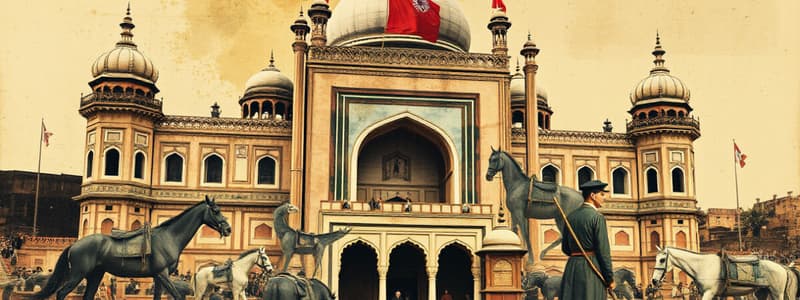Podcast
Questions and Answers
What significant challenge did rulers face in governing the Indian subcontinent during the Middle Ages?
What significant challenge did rulers face in governing the Indian subcontinent during the Middle Ages?
The significant challenge was managing the diverse range of people and cultures across a large territory.
How did the Mughal Empire differ from previous empires in the Indian subcontinent?
How did the Mughal Empire differ from previous empires in the Indian subcontinent?
The Mughal Empire created a lasting political legacy and governance structures, expanding from Agra and Delhi to control nearly all of the subcontinent.
From which two historical figures did the Mughals claim descent?
From which two historical figures did the Mughals claim descent?
The Mughals claimed descent from Genghis Khan and Timur.
Why did the Mughals prefer not to be referred to by the name 'Mughal' or 'Mongol'?
Why did the Mughals prefer not to be referred to by the name 'Mughal' or 'Mongol'?
What is the significance of the Red Fort in Delhi in relation to Mughal history?
What is the significance of the Red Fort in Delhi in relation to Mughal history?
What role did the Mughals play in the administration of the Indian subcontinent?
What role did the Mughals play in the administration of the Indian subcontinent?
During which century did the Mughals significantly expand their empire?
During which century did the Mughals significantly expand their empire?
Who were Timur's descendants in relation to Babur, the first Mughal emperor?
Who were Timur's descendants in relation to Babur, the first Mughal emperor?
At what age did Babur succeed to the throne of Ferghana?
At what age did Babur succeed to the throne of Ferghana?
What prompted Babur to leave his ancestral throne?
What prompted Babur to leave his ancestral throne?
Which battle did Babur win to capture Delhi and Agra?
Which battle did Babur win to capture Delhi and Agra?
How was Humayun’s relationship with Safavid Iran different from Akbar’s?
How was Humayun’s relationship with Safavid Iran different from Akbar’s?
What role did cannons play in sixteenth-century warfare according to Babur?
What role did cannons play in sixteenth-century warfare according to Babur?
What immediate threat did the Afghans pose to Mughal authority?
What immediate threat did the Afghans pose to Mughal authority?
What regions saw the first use of firearms in warfare?
What regions saw the first use of firearms in warfare?
Did the annexation of Golconda and Bijapur in Aurangzeb’s reign end hostilities in the Deccan?
Did the annexation of Golconda and Bijapur in Aurangzeb’s reign end hostilities in the Deccan?
Who defeated the Sultan of Delhi, Ibrahim Lodi?
Who defeated the Sultan of Delhi, Ibrahim Lodi?
What image did Mughal emperors celebrate regarding their ancestry?
What image did Mughal emperors celebrate regarding their ancestry?
Flashcards are hidden until you start studying
Study Notes
The Mughal Empire Overview
- The Mughal Empire successfully ruled the Indian subcontinent, encompassing a diverse range of cultures and peoples during the Middle Ages.
- Unlike previous rulers, the Mughals maintained a long-lasting empire from the late 16th century to the mid-17th century, expanding from Agra and Delhi.
- By the 17th century, the Mughals controlled nearly the entire subcontinent, establishing a political legacy that influenced future governance.
Mughal Lineage and Identity
- The Mughals descended from two notable lineages: Genghis Khan from their mother’s side and Timur from their father’s side.
- Genghis Khan's legacy included significant violence, which the Mughals distanced themselves from, preferring to emphasize their Timurid heritage.
- The Mughals honored their genealogy with symbolic portraits that included Timur and each ruler, showcasing their pride in lineage linked to the capture of Delhi in 1398.
Key Figures and Initial Expansion
- Babur, the first Mughal emperor (1526-1530), ascended to the throne of Ferghana at age 12 in 1494 but lost his kingdom to the Uzbegs.
- After years of displacement, Babur captured Kabul in 1504, then defeated Sultan Ibrahim Lodi at the First Battle of Panipat in 1526, leading to the conquest of Delhi and Agra.
Military Technology and Strategies
- The Mughal army integrated cannons and gunpowder technology into warfare, dramatically enhancing military capabilities in the 16th century.
- The introduction of firearms in regions like Gujarat, Malwa, and Deccan marked a shift in regional warfare tactics.
Political Dynamics and Relationships
- The initial threats to Mughal authority included Afghan tribes, showing the complex interplay of power in the region.
- Relationships with groups like the Ahoms, Sikhs, and Rajput states (Mewar and Marwar) were fundamental to both conflict and governance in Mughal politics.
Notable Campaigns and Challenges
- An analysis of Mughal campaigns reveals patterns of conflict and consolidation, particularly regarding resistance from the Afghans.
- The shifting dynamics between Mughal emperors, such as Humayun's complicated ties with Safavid Iran compared to Akbar's, signify changes in foreign relations.
End of Hostilities
- Aurangzeb's annexation of Golconda and Bijapur raised questions about whether this concluded ongoing conflicts in the Deccan, highlighting the challenges of prolonged governance.
Studying That Suits You
Use AI to generate personalized quizzes and flashcards to suit your learning preferences.




